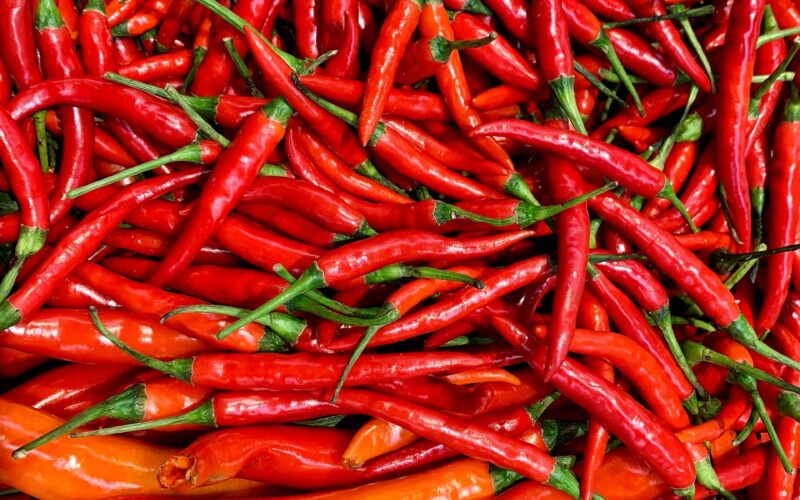The hot red chilli pepper is well-known among eaters of spicy cuisine. But did you realize that in addition to its delicious flavor, this little fruit is packed with beneficial properties? Many studies have shown that adding a sprinkle of red chilli to your diet has positive health effects, including increased metabolism, decreased inflammation, and improved digestion. It’s crucial to understand the risks involved. In this article, we’ll discuss the ins and outs of red chilli, including its health advantages and potential drawbacks.
Explain the concept of a red chilli
Red chilli is a kind of dried capsicum fruit used as a spice. It’s a common way to spice up a meal.
Capsaicin is what gives cayenne pepper its spicy flavor. As a spice, chilli peppers can be either cooked or dried and ground into a powder. Paprika is the common name for a powder made from ground red chilli peppers. This compound, which also works as an irritant and causes a burning sensation when it comes into contact with the skin or mucous membranes, is responsible for chili’s distinctively pungent flavor.
Pain and itching can be soothed using capsaicin ointments and lotions. It’s also found in self-defense weapons like pepper spray.
There are both beneficial and harmful effects of red chilli on the body. Moderate consumption has been shown to improve metabolic rate and promote fat loss. However, consuming an excessive amount of chilli might cause stomach discomfort.
Red chilli peppers and their variations
Cayenne pepper, paprika, and chilli powder are just a few examples of the many varieties of red chilli available. All of these seasonings come from various chilli peppers.
Cayenne pepper is a kind of chilli pepper whose powdered, dried pods are used as a seasoning. It’s a common way to spice up a meal.
Paprika is a kind of chilli pepper who’s powdered, dried fruit is used as a seasoning. Foods get a boost in flavor and vibrancy from using it.
Various types of chilli peppers are dried and processed into powder to create chilli powder. It’s a common way to spice up a meal.
The value of hot peppers
A staple of many international cuisines is the fiery red chilli pepper. Its unique, pungent flavor may spice things up and give them more depth. Although it is most often used in savory recipes, it may be used in any dish that needs a little more kick.
A variety of health advantages have been linked to red chilli. Folate, potassium, and vitamins A, C, and E may all be found in sufficient amounts in this food. Also included is the chemical capsaicin, which has been demonstrated to reduce inflammation and kill microorganisms. As a bonus, it speeds up your metabolism and facilitates fat loss.
Food may be made more flavorful with only a sprinkle of red chilli.
Red chilli’s negative effects
Capsaicin, found in red chilli peppers, is known to aggravate conditions including heartburn and ulcers. In addition to causing stomach pain, consuming too much capsaicin can irritate your skin and mucous membranes. Anaphylactic shock can even occur, but quite rarely. Red chilli peppers can cause an allergic reaction in certain people. You should see a doctor right away if eating red chilli peppers causes any of these symptoms.
Recipes for using hot pepper
Red chilli is much like any other kind of chilli in that it may be found in a wide variety of dishes. It’s versatile enough to be utilized in a wide range of meals. Here are some suggestions for working with red pepper flakes:
The seeds and veins of a red chilli should be removed before using it in a recipe. The dish’s heat level will be lowered thanks to this.
You may use red pepper in several forms: whole, diced, or ground.
Roasting or frying the chilies before adding them to your recipe is a great way to bring out their full flavor.
Red pepper flakes recipes
The fiery red chilli pepper is a mainstay of many international cuisines. They are versatile and may be used in both sweet and savory recipes to provide their own special flavor. Here are a few dishes that call for red chillies:
The use of fiery red chilies elevates the flavor of this chicken curry to new heights. Coconut milk, tomatoes, and onions make up the curry sauce that the chicken is bathed in during cooking. A full dinner when served over steamed rice.
This stir-fried red chilli beef is a great dish for a busy weekday. Soy sauce, garlic, ginger, and red chilli peppers are stirred into the meat. Pair with a side of rice or noodles.
This red chilli paste has a wide range of culinary applications. It has dried red chilies, garlic, ginger, and vinegar as its main ingredients. Soups, stews, and curries all benefit from having it added to them.
Conclusion
Red chilli is a multipurpose spice that adds heat and taste to a wide variety of foods while also providing nutritional benefits. Although it can assist with digestion and decrease inflammation, it’s still best to limit your intake owing to the possibility of adverse effects. The information provided in this article should help you make an informed decision about the safety of red chilli and its many possible applications.




